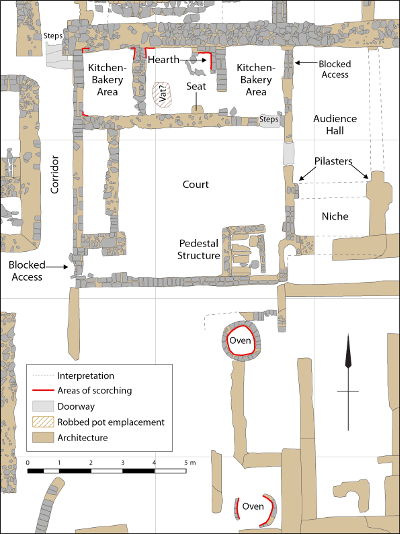This year we returned to area AA-South, which is just just south of the Pedestal Building. We were on the lookout for evidence of beer brewing, but instead we found a large structure, which was probably an official residence, that is, an office and residence. What did this house’s residents administer? We still think it included brewing, but we are certain that production in this area including baking.
 At the beginning of the season, we hypothesized that two circular mudbrick burnt-red structures in the south served as sockets for the large vats in which brewers heated malt soaked in water. Instead, these circles turned out to be ovens used for baking bread and three rooms in the north of the house served as kitchen/bakery areas. The second room featured a hearth, lined with broken stone and mudbrick, built into the northeast corner. An upside down bread mold formed a corner post, just as we have seen in hearths at other bakeries in the Heit el-Ghurab site. Bakers used these corner hearths for preheating the bread molds. A hole in the floor of the southwest corner of the chamber must have once held a dough-mixing vat. A worn, rounded, limestone boulder against the southern wall allowed someone to sit and turn left to reach into the vat, or right to stoke the hearth.
At the beginning of the season, we hypothesized that two circular mudbrick burnt-red structures in the south served as sockets for the large vats in which brewers heated malt soaked in water. Instead, these circles turned out to be ovens used for baking bread and three rooms in the north of the house served as kitchen/bakery areas. The second room featured a hearth, lined with broken stone and mudbrick, built into the northeast corner. An upside down bread mold formed a corner post, just as we have seen in hearths at other bakeries in the Heit el-Ghurab site. Bakers used these corner hearths for preheating the bread molds. A hole in the floor of the southwest corner of the chamber must have once held a dough-mixing vat. A worn, rounded, limestone boulder against the southern wall allowed someone to sit and turn left to reach into the vat, or right to stoke the hearth.
The most tantalizing find in this area though was another audience hall, with pilasters and a southern niche, similar to the pilaster-and-niche chamber that we found this year in Standing Wall Island. This find substantiated our hypothesis that in AA-S we were excavating another official’s house.
This discovery of yet another large house adds to a picture of the houses of prominent people as organizing nodes of the Heit el-Ghurab proto-city. High-status administrators probably had their houses built as the first, core structures of the neighborhood. These houses served as their official residences and offices when they came to Giza to be on the job at the site of the royal building works.
The level of preservation in this part of the site is excellent and we were able to identify staircases, blockings, and wall decorations. In one room, a black band projected forward from pink mortar just above. These bands probably belonging to a dado, once topped by strips of red and white, similar to images depicted in tomb scenes of domestic settings, for example, in the scene of Wa’etetkehthor and Mereruka on their bed.
Thank you to all our members for helping to make this season possible. We look forward to returning to this area in 2016 to further investigate this house and its surrounding neighborhood to see what else we find!
